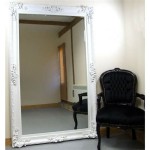Samsung TV with Mirror Front: A Blend of Technology and Interior Design
The concept of a television seamlessly integrating into home décor has driven innovation in television design. Samsung, a leader in display technology, has explored this concept through the development of televisions featuring mirrored fronts. These innovative displays function as mirrors when turned off, effectively disappearing into the room's aesthetics, and transform into vibrant televisions upon activation. This article explores the technology, benefits, and potential applications of Samsung TVs with mirror fronts.
The Technology Behind the Reflective Display
The core technology enabling this dual functionality is a specialized semi-transparent mirror. When the TV is off, the mirror reflects ambient light, creating the illusion of a conventional mirror. However, when the TV is turned on, light from the display panel passes through the semi-transparent mirror, overriding the reflection and displaying the intended image. This intricate balance requires precise engineering to ensure both a clear reflection when off and a vibrant, high-quality image when on.
The quality of the mirror and the display panel are crucial. The mirror needs to provide a distortion-free reflection, mimicking the quality of traditional mirrors. The display panel, on the other hand, needs to be bright enough to overcome the reflective properties of the mirror and deliver a clear picture, even in brightly lit environments. This necessitates the use of high-quality display technologies, such as QLED or OLED, to ensure sufficient brightness and contrast.
Aesthetic Integration and Space Optimization
One primary advantage of mirrored TVs is their ability to seamlessly blend with interior design. In traditional settings, a large black rectangle can disrupt the carefully curated aesthetic of a room. Mirrored TVs address this issue by transforming into reflective surfaces when not in use, effectively disappearing into the background. They can complement existing décor, reflecting the room's colors and light, and creating a sense of spaciousness.
This integration is particularly valuable in smaller living spaces. By eliminating the visual dominance of a traditional TV, mirrored TVs can make rooms appear larger and less cluttered. They can be strategically placed in bedrooms, bathrooms, or hallways without compromising the aesthetic appeal of these spaces. This dual functionality maximizes space utilization, offering both entertainment and practicality within the same footprint.
Applications Beyond Residential Use
While the residential market is a primary target for mirrored TVs, the applications of this technology extend beyond the home. In commercial settings, such as retail stores, hotels, and restaurants, mirrored TVs can serve multiple purposes. They can function as digital signage displaying promotional content, seamlessly transitioning into mirrors when not in use, preserving the aesthetic integrity of the space.
In hospitality settings, mirrored TVs can provide guests with entertainment options while maintaining a sophisticated ambiance. In retail environments, these displays can showcase product information and advertisements, blending into the store's design when inactive. This versatility makes mirrored TVs a valuable tool for businesses seeking to enhance customer engagement and brand experience.
The Future of Mirrored TV Technology
Ongoing advancements in display technology and materials science promise to further enhance the capabilities of mirrored TVs. Improvements in transparency and reflectivity will lead to even more seamless integration with interior design. Additionally, the development of thinner and more flexible displays could open up new possibilities for incorporating mirrored TVs into various surfaces and furniture, further blurring the lines between technology and design.
Further research and development are also focusing on improving the energy efficiency of these displays. Optimizing the power consumption of both the mirror and the display components is crucial for creating a sustainable and environmentally friendly product. As technology progresses, we can expect to see continued innovation in this space, leading to even more sophisticated and integrated solutions for the future of home entertainment and beyond.
Customization and Personalization
The reflective surface of the mirrored TV offers an opportunity for customization. Frame designs and styles can be tailored to match specific interior design preferences. This allows homeowners and businesses to seamlessly integrate the technology into their existing décor. Further customization could potentially include options for adjusting the reflectivity of the mirror itself, allowing for varied levels of transparency and reflection depending on individual preferences and lighting conditions.
This personalized approach to technology integration empowers users to create a truly bespoke entertainment experience. By allowing for custom framing and potentially even interactive mirror features, mirrored TVs offer a unique blend of functionality and aesthetics that traditional televisions cannot match. This level of personalization contributes to the increasing demand for technology that seamlessly integrates with, and enhances, daily life.

75 Framed Samsung Led Mirror Tv Model Un75ju641

Samsung Mirror Tv Complete Guide For 2024 Models

Samsung Mirror Tv Complete Guide For 2024 Models

Vanity Mirror Tv Vanishing Television For Your Bathroom

Samsung Mirror Tv Complete Guide For 2024 Models

50 Inch Samsung Qled Q60 Framed Mirror Tv In Disguise

Creative Tvs With Rollable Screens Art Frames And Easels Wirecutter

Creative Tvs With Rollable Screens Art Frames And Easels Wirecutter

Hau8000 Crystal Uhd 4k Hotel Tv Hg50au800auxue Samsung Business Levant

32 Hd T4300 Smart Tv Samsung Es








